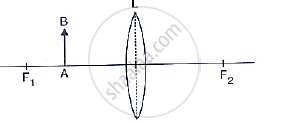Advertisements
Advertisements
Question
The following diagram shows an object AB and a converging lens L with foci F1 and F2 State three characteristics of the image in relation to the object.

Solution
The image formed will be erect, virtual and enlarged.
APPEARS IN
RELATED QUESTIONS
The speed of light in air is 3 × 108 m s-1. Calculate the speed of light in glass. The refractive index of glass is 1.5
A lens forms an erect, magnified and virtual image of an object.Draw a ray diagram to show the formation of image.
The focal length of a convex lens is 25 cm. At what distance from the optical centre of the lens an object be placed to obtain a virtual image of twice the size?
An illuminated object lies at a distance 1.0 m from a screen. A convex lens is used to form the image of the object on a screen placed at a distance of 75 cm from the lens. Find:
- the focal length of the lens, and
- the magnification.
The maximum magnifying power of a convex lens of focal length 5 cm can be ______.
Why is the focal length of the lens, used as a magnifying glass, kept short?
A convex lens produces on a screen an image twice the size of the object. If the position of image and object be interchanged, what will be the magnification then?
Show with the help of a ray diagram, the path of the ray when incident normally on the first surface of the glass block, through the block and the liquid.
Draw a neat diagram to explain the action of a convergent (convex) lens as a reading glass (or magnifying glass). State the characteristics of the image formed.
What is a magnifying glass (or a simple microscope)? Draw a ray diagram to show how a convex lens may be used as a magnifying glass. Where should the object be placed? State three characteristics of the image formed.
